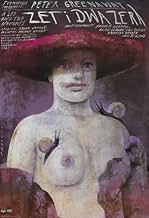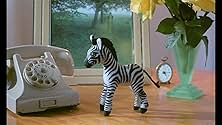Les zoologistes jumeaux perdent leur femme dans un accident de voiture et deviennent obsédés par les animaux en décomposition.Les zoologistes jumeaux perdent leur femme dans un accident de voiture et deviennent obsédés par les animaux en décomposition.Les zoologistes jumeaux perdent leur femme dans un accident de voiture et deviennent obsédés par les animaux en décomposition.
- Réalisation
- Scénario
- Casting principal
Avis à la une
Greenaway's obsessions with lists, wordplay, coincidence, sexuality, the surreal, and the explicit (not to mention the "conventionally used" ones like men and women, birth and eating and death, physiology (formal and psychological), and abstraction) come to a head in this film. A bizarre mileau of fancy digressions and focused narrativity create a film which is perhaps too obtuse for first time viewers but is, as far as I'm concerned, the best way to initiate oneself into the "world" of Greenaway.
For better or for worse, A Zed & Two Noughts is a very unusual film. This is hardly surprising given that it was directed by the avant-gardist director Peter Greenaway. It begins with a car accident at a zoo, where two women are killed when their vehicle collides with a pregnant swan. These women are twins who were in turn married to a couple of twin zoologists, Oliver and Oswald Deuce. Shortly afterwards these men start simultaneous affairs with the survivor of the accident, the driver Alba Bewick who lost a leg as a result of the crash. She later has the other one removed surgically for symmetrical reasons and falls pregnant to the twins.
This strange film features both the good and the bad typical of Greenaway. The good is the visual presentation and distinctive bizarre qualities, the bad is more or less any time someone opens their mouths, which unfortunately is quite often. Greenaway is really terrible at writing dialogue. His script constantly tries to be clever, which is not the same thing as actually being clever. Needless to say, the dialogue is painful to listen to and ultimately makes the film hard work and not in a good way. But setting this aside, amongst other things, it's an intriguing concoction about symmetry, birth and decay. Of the latter are several time-lapse films showing a variety of animals and organic matter decaying - films which were fascinating and repulsive in equal measure. We also have excellent cinematography from Greenaway's common collaborator Sacha Vierney, with many shots being a joy to behold. The other significant cog in the wheel is the typically persistent minimalist score from Michael Nyman, which is sometimes brilliant even if it does border on irritating at others. We also have the most unexpected collaborator in any Greenaway film - none other than Jim 'Nick Nick' Davidson, the politically incorrect stand-up comedian who appears as a zoo-keeper.
In summary, A Zed & Two Noughts was an interesting film spoiled by Greenaway's horrible dialogue and awful characters. If you can get beyond those it does offer some fascinating stuff but you sure have got your work cut out with this one.
This strange film features both the good and the bad typical of Greenaway. The good is the visual presentation and distinctive bizarre qualities, the bad is more or less any time someone opens their mouths, which unfortunately is quite often. Greenaway is really terrible at writing dialogue. His script constantly tries to be clever, which is not the same thing as actually being clever. Needless to say, the dialogue is painful to listen to and ultimately makes the film hard work and not in a good way. But setting this aside, amongst other things, it's an intriguing concoction about symmetry, birth and decay. Of the latter are several time-lapse films showing a variety of animals and organic matter decaying - films which were fascinating and repulsive in equal measure. We also have excellent cinematography from Greenaway's common collaborator Sacha Vierney, with many shots being a joy to behold. The other significant cog in the wheel is the typically persistent minimalist score from Michael Nyman, which is sometimes brilliant even if it does border on irritating at others. We also have the most unexpected collaborator in any Greenaway film - none other than Jim 'Nick Nick' Davidson, the politically incorrect stand-up comedian who appears as a zoo-keeper.
In summary, A Zed & Two Noughts was an interesting film spoiled by Greenaway's horrible dialogue and awful characters. If you can get beyond those it does offer some fascinating stuff but you sure have got your work cut out with this one.
This is definitely one of the more disgusting films I've watched, and not in a good way. This movie made me physically ill, and though it was mind-bending and beautifully coreographed, the subject matter and the lead characters' inevitable decline into utter insanity that is characteristic of Greenaway films was a bit much for me. I'm saying this and I loved Santa Sangre. Go figure.
A pair of twin brothers (who have different hair color somehow, and as it turns out were originally Siamese twins) become obsessed with the subjects of decay, evolution, and greif when their wives are killed in a car crash at the Zoo. They start conducting utterly repulsive experiments that involve time-elapse films of animals and fruits rotting away. And to top it all off, there's a plot in all of this, by a couple of poachers posing as zoo staff who plan to make a profit from all this. The rest is just entirely too disgusting/weird/complicated to explain clearly, but I will give you some hints about the ending: It involves a rack. And snails. And floodlights. And a record player.
A pair of twin brothers (who have different hair color somehow, and as it turns out were originally Siamese twins) become obsessed with the subjects of decay, evolution, and greif when their wives are killed in a car crash at the Zoo. They start conducting utterly repulsive experiments that involve time-elapse films of animals and fruits rotting away. And to top it all off, there's a plot in all of this, by a couple of poachers posing as zoo staff who plan to make a profit from all this. The rest is just entirely too disgusting/weird/complicated to explain clearly, but I will give you some hints about the ending: It involves a rack. And snails. And floodlights. And a record player.
A Zed and Two Noughts (or Zoo) is Greenaway's best film. Made during the transition between his early experimental short films and his later more narrative (and more celebrated) ones, his free flowing structure is at its best here, fresh, witty and cerebral (some would also say pedantic). In later films, one has the feeling that Greenaway has try to go back to the style set by Zoo, but the results (like in 8 1/2 women) are almost unwatchable. The plot: two biologists twins working in a zoo, specialized in studying the putrefaction of animals, lose their wives in a car accident. They hook up with a strange woman who lost her leg in that accident. Meanwhile, there are references to Vermeer throughout (what does this has to do with zoology, only Greenaway knows), speeded up shots of real rotting animals, Michael Nyman's hypnotic score, and also a girl who learns the alphabet through giant letters that are linked with live animals (for example, z is for zebra, as in a children's book). Deliberately non naturalistic, Greenaway makes from this strange melange a very compelling movie, though undoubtedly very hard to take for some.
This fine film is written in an intelligent, multilayered way of such a degree and quality as I have only seen in top-notch theatre. Greenaway delivers a dark but intoxicating tale of decay, evolution and the crucial importance of symmetry.
The themes of this film emerge not only through Greenaway's script, but also through the images produced by his tight, clear directing. The choice of images and ability to linger on single shots suggests a creative mind as focused and obsessed as the characters he portrays.
As with many of Greenaway's works, this certainly isn't a film for anyone wanting a cheap thrill and easy satisfaction. Its particularly dark humour and images of accelerated decay and death are more likely to please those who prefer to view film as a medium of art than those seeking mere entertainment.
It is a very long time since a film has impressed me quite as much as this.
The themes of this film emerge not only through Greenaway's script, but also through the images produced by his tight, clear directing. The choice of images and ability to linger on single shots suggests a creative mind as focused and obsessed as the characters he portrays.
As with many of Greenaway's works, this certainly isn't a film for anyone wanting a cheap thrill and easy satisfaction. Its particularly dark humour and images of accelerated decay and death are more likely to please those who prefer to view film as a medium of art than those seeking mere entertainment.
It is a very long time since a film has impressed me quite as much as this.
Le saviez-vous
- AnecdotesThis film was Peter Greenaway's first collaboration with cinematographer Sacha Vierny, who went on to shoot virtually all of Greenaway's work in the 1980s and 1990s, until Vierny's death in 2001. Greenaway referred to Vierny as his "most important collaborator".
- Citations
Alba Bewick: In the land of the legless the one-legged woman is queen.
- ConnexionsFeatured in Peter Greenaway (1992)
- Bandes originalesThe Teddy Bears' Picnic
Music by John W. Bratton
Lyrics by Jimmy Kennedy
Performed by The BBC Dance Orchestra
Directed by Henry Hall
Courtesy of EMI MUSIC PUBLISHING LTD and EMI RECORDS LTD
Also sung by Venus De Milo (Frances Barber)
Meilleurs choix
Connectez-vous pour évaluer et suivre la liste de favoris afin de recevoir des recommandations personnalisées
- How long is A Zed & Two Noughts?Alimenté par Alexa
Détails
- Date de sortie
- Pays d’origine
- Langues
- Aussi connu sous le nom de
- A Zed & Two Noughts
- Lieux de tournage
- Sociétés de production
- Voir plus de crédits d'entreprise sur IMDbPro
Contribuer à cette page
Suggérer une modification ou ajouter du contenu manquant




















